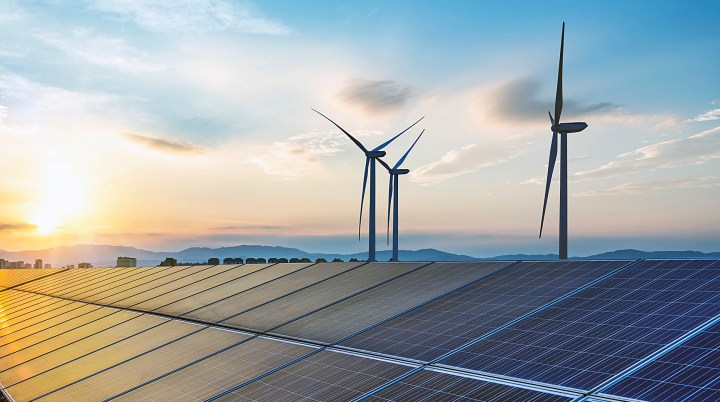POWER CRISIS
SA’s energy revolution — we’d better put plans into action… fast, expert warns

Although South Africa is making headway when it comes to new power generation, the country is moving far too slowly, says Anton Eberhard, an emeritus professor at the University of Cape Town.
Inverters, batteries, solar panels, transmission access, wind farms, the search for gas… The energy crisis facing us is massive and few of us are equipped to understand what the hell is going on.
A few years ago, we sat around a table in Stanford in the Western Cape listening to engineering boffins suggesting that the time had come for our little village to divorce itself from Eskom using solar energy to keep the lights on.
We all loved the idea.
Stanford would be the first village in Africa to do so. Then came Covid and we were so busy giving the unvaccinated a wide berth that we forgot about the solar story, and worried whether we would live long enough to see any light at all.
Anton Eberhard, emeritus professor in the Power Futures Lab at the University of Cape Town’s Graduate School of Business – an everyman when it comes to energy activism – reminded us this week that the visionary fairy tale we thought was a bit dotty at the time may not be so far off the mark after all.
“It’s still a valid concept, but visionary ideas of going it alone have moved far forward since then. In fact, right now we are in the midst of an energy revolution sweeping the world. It’s unstoppable.”
At the heart of this revolution are the sun and the wind, now the cheapest source of electricity, coupled with storage. In my own mind I ask why has it taken so long to harness something that’s been there for billions of years.
The frustration, he explains, is the reluctance of key players in the ruling party to embrace this radical energy transition. It has to do with a number of things – “political ideology, vainly believing Eskom can still be an instrument of a developmental state when plainly it is not, suspicion of the private sector, personal gain, corruption, criminal syndicates. And it’s costing the country dearly.”
Like many academics, Eberhard has a quietly measured way of describing the issues at hand. So, when pictures of damaged coal power facilities (often touted as the way out of the crisis) appear like scenes from an active war zone in Ukraine, the urgency of what he is saying hits home.
The hub and nub of South Africa’s power emergency is this, says Eberhard:
Eskom is broken; it has lost too many skills; old power plants have been poorly maintained and cannot easily be revived, no matter how much taxpayers’ money is thrown at them. Gone is the culture of excellence it once had. It has had 15 CEOs in 15 years.
Read more in Daily Maverick: Eskom news
Coal power is dead in the water, and no banks will finance it alongside international understanding of the need to reduce the carbon footprint.
Eskom’s coal units are failing at a rate faster than new generation is being added. The energy minister’s power procurements over the past five years have resulted in only 150MW being connected to the grid when we need 6,000MW or 8,000MW of additional power now.
Eskom electricity prices have nearly trebled in 10 years. In 2014, a kWh tariff was 67.9 cents. The tariff now is R1.86 and from April it will rise to R2.01. The less electricity consumers use, the more Eskom needs the price to go up to earn sufficient revenue.
In 2023, Eskom’s loss was R23-billion and the utility is technically insolvent, surviving only on fiscal bailouts.
In Eskom’s own words, the utility has an outdated business model which is in a “death spiral”; it has operational and structural inefficiencies and a lack of transparency; and it needs to embrace the energy transition. This was all said five years ago.
A pack-for-Perth scenario? But, and thank goodness there is a but, there is light at the end of this long, dark tunnel.
The President’s Energy Plan appears at last to be taking shape, says Eberhard, who chaired Cyril Ramaphosa’s Eskom Sustainability Task Team in 2018/19 – 20 years after the country’s Energy Policy White Paper was first mooted.
“Solar and wind energy are fast taking over as the energy leaders thanks to technological innovation, including new ways of stabilising the national power systems, as the share of these variable sources on the transmission grid increases. In Australia, for example, rooftop solar has reformed and streamlined the energy market, with 3.2 million householders becoming major providers, in effect equivalent to a virtual power station. No reason why we can’t do the same,” he says.
In South Africa there will be a need to add more than wind and solar to the energy mix in the immediate future. Although a controversial issue, this will also include gas. The gas reserves in the Mozambican Pande and Temane fields, says Eberhard, are predicted to run out by 2030. And, he warns, Sasol has already given notice that it will terminate supplies to industrial users by 2026.
“If I can predict the future, it will be that Namibia’s economy will grow rapidly as its recently discovered offshore oil and gas resources are developed. If South Africa were to provide a more favourable enabling environment, then its resources off Mossel Bay and in the Orange River basin could also be developed, providing a flexible resource to complement the variability of solar and wind energy.”
South Africa, he believes, has a narrow window of opportunity to put these energy plans into action.
“While the interventions at Eskom are positive and there are encouraging signs of private investment in generation, we are moving far too slowly on new power generation. More than R1-trillion, 60GW, is needed by 2030. We are way off those targets.” DM
Professor Anton Eberhard was addressing an Overstrand Stanford Probus meeting two weeks ago. Probus is a local, national and international association of retired people who come together in non-political, non-sectarian, non-profit, autonomous clubs.
Cape Town is turning electricity consumers into power sellers
Solar cashbacks are part of the policy changes that are changing the energy landscape in Cape Town.
Mayor Geordin Hill-Lewis says technological advances in the power generation sector have transformed electricity consumers into power sellers earning credits against their total municipal bill, and receiving cash for power fed back into the grid.
Previously, sellers could only be credited against their electricity bill up to a zero balance.
Businesses and households have earned more than R25.8-million under the city’s Cash for Power programme since the start of the 2022/23 financial year.
In an interview with Alec Hogg of BizNews, Hill-Lewis said the key to rolling out this system of energy provision and buyback for municipalities around the country was having a stable and solvent financial status.
Since the beginning of February 1,461 sellers have benefited from Cape Town’s Cash for Power scheme as part of the City’s broader plans to end load shedding over time.
“That must be the future for our country too,” said Hill-Lewis.
Cape Town was showing the way, the mayor added.
“The most exciting part is that residents and businesses are going to play a crucial role in helping us to end load shedding by working together as Team Cape Town.”
For more information click here. DM
This story first appeared in our weekly Daily Maverick 168 newspaper, which is available countrywide for R29.























 Become an Insider
Become an Insider
Renewables are now the cheapest electricity globally and the fastest to roll out. Grid feed PV using a FIT (Feed In Tariff Scheme) has been the global standard for promoting rollout. This is complemented by BESS (utility scale battery storage systems). Finance is available. Due to transmission network constraints, PV has to use rooftop and local installations. The City of Cape Town is in a favourable financial position to qualify for financing. Unfortunately the rest of the metros are all bankrupt and would not qualify as the all owe billions to Eskom and Rand Water.
It has been the indecision of the ANC which has caused this in the first place. The ANC politicians are like stubborn teenagers who keep on doing it their way instead of listening to the parent’s warnings. Unfortunately, after 30 years there still has not been any evidence of growing up.
We’ve been saying all this for 20 years. We have an intransigent, no-good minister running DME who has added exactly 3% of energy generation into the grid. The ANC is stuck on nuclear procurement, 20 years into the future to build. We need renewable energy capacity NOW. But we have political dinosaurs in the way, blocking up progress like a pile of poo in a pipe.
This is Africa….nothing happens fast in Africa these days!
You can generate as much renewable energy (mostly located in the N-Cape) as you want but, in the absence of transmission lines, that power cannot get to the large users (mostly located in the PWV).
It’d be interesting to figure how big that transmission capacity issue really is. Between Eskom and JHB they are screaming they need over R400 billion for networks.
In theory a line and the transmission & distribution gear that carried power from generation sources to consumers can carry the same in reverse. So if Kakamas was an end point and it had 100MW capacity, then Kakamas can have 100MW generation capacity.
No, actually more because Kakamas only needs to export the surplus after deducting what the consumers in Kakamas consume. I.e put down much more than 100MW solar plus a big battery and export, after deducting Kakamas consumption, at all times 100MW minimum while generating say 150MW. The systems exist right now to manage that surplus export to rest of grid with less than a second adjustment.
I may not be explaining well, but a 100MW transmission arm could have much more than 100MW generation capacity solar. The consumers on that arm take say 350 GWh per year while the transmission capacity is 880GWh, so a solar plus storage system can inject 1200 GWh a year.
You can cover SA with solar and wind generators, but there will always be lulls. City size batteries are a joke. You must build real power generation. Small nuclear plants can be placed where needed and you don’t need long transmission lines in that scenario.